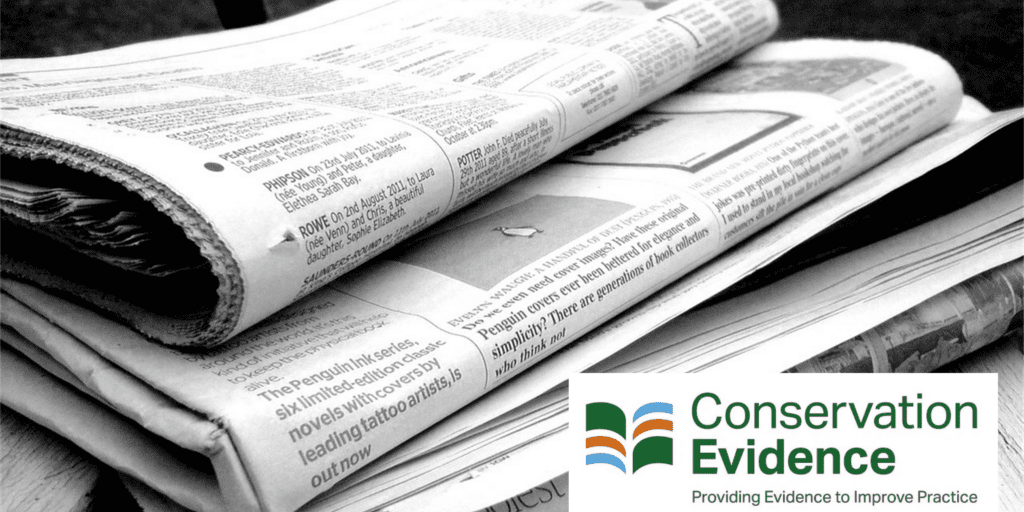Challenges and opportunities for evidence-based development mitigation
This blog was written by Bronwen Hunter, a PhD student at the University of Sussex who recently completed her MSc at Imperial College, London, where she conducted research on the evidence for ecological mitigation measures. Her current work focuses on the application of text-analysis tools to global analyses of wildlife exploitation.
What is ecological mitigation?
In the UK, the legal protection of species means that, if an infrastructure development is set to impact local species populations, developers must minimise this impact and compensate for any disturbance or loss of habitat. Hence, ecological mitigation measures, usually recommended by consultants during ecological impact assessment, have become a keystone policy tool intended to resolve the conflict between development and species conservation. Given the UK governments recent commitments to building 300,000 new homes per year over the next ten years, these measures are vitally important. However, despite their importance and widespread application, practitioners (Hill & Arnold, 2012) have previously indicated there may be limited evidence for the effectiveness of ecological mitigation.

What is the evidence?
In our recently published paper (Hunter et al. 2021), we aimed to investigate this evidence gap by identifying the protected species mitigation measures used in developments, exploring the guidance that informed them and, using the Conservation Evidence database, evaluating the scientific evidence for their effectiveness. In reviewing the ecological reports associated with a sample of 50 housing developments, we found 446 measures recommended in total, comprising 65 different mitigation measures relating to eight taxa – over half of these measures have not been empirically evaluated and only 13 are assessed as beneficial or likely beneficial.
When we investigated the guidance informing these measures, we found that it often lacked reference to scientific evidence for effectiveness. In fact, the most frequently cited literature in the guidance we reviewed was actually other guidance publications. What is more, the guidance was also out-of-date, with the majority being published over ten years ago. For example, one of the most highly cited guidance publications for amphibians and reptiles was published in 1998 and referenced no empirical literature to support its claims.
Implications of evidence gaps
Given the wide application of ecological mitigation measures, these results are certainly cause for concern. The limited number of measures identified as being beneficial raises questions of the efficacy of current mitigation practice in compensating for the impact of rapid development. Our findings also cast doubt over the cost-effectiveness of mitigation. Lewis et al. (2016) noted that £20-43 million is spent on great crested newt mitigation per year. Yet, most measures applied to this species in our study lacked evidence for their effectiveness.
The lack of updated guidance, combined with circular referencing of other guidance, means that ineffective mitigation measures could continue to be applied, despite new evidence. However, the absence of conclusive evidence for the effectiveness of ecological mitigation not only means that we lack understanding of the biodiversity outcomes of developments, but also creates difficulties in updating guidance. This conundrum is illustrated by the practice of destructive search, a measure commonly used to remove amphibians and reptiles from development sites. In 2011, Natural England released an updated set of reptile mitigation guidelines, which claimed that destructive search was harmful. However, this document was quickly retracted, due to controversies around its recommendations. As a result, this measure was still recommended in several ecological reports we reviewed.
Improving evidence use in ecological mitigation
The recommendation of measures unsupported by scientific evidence and the limited reference to scientific evidence in guidance could suggest that evidence is not being sought to inform decisions. This ‘evidence complacency’ has been highlighted as an issue in conservation practice (Sutherland & Wordley, 2017). Nonetheless, undertaking a full evidence review to update guidance or inform project-level decision making is hugely resource intensive (and often unrealistic). Moreover, ecological consultants often work to different targets and constraints than mainstream conservation organisations – decisions around ecological mitigation are likely to be primarily driven by cost and adherence to legislative requirements (as set out in published guidance).

What we need is an evidence-overhaul for development mitigation – we need to address both the creation of new evidence and the integration of evidence into practice. We hope that the evidence gaps we identified in our research can be addressed through increased research effort directed towards ecological mitigation. Experimental testing of measures could help to identify those that do and don’t work, whilst utilising pre-and post-development monitoring data could help us understand whether measures have been applied appropriately and proportionally to development impacts. Stronger requirements to undertake species population monitoring, and to make this data publicly available, would help close the gap between research and conservation practice. This could also help to increase transparency, so that developers can be held accountable when mitigation is poorly implemented.
We also need to ensure that any newly generated evidence is integrated into guidance – new guidance could also utilise experiential evidence or professional judgment to inform recommendations. Although our paper used the Conservation Evidence database as a research tool, its primary purpose is as a decision-making tool for practitioners. Our research has demonstrated that mitigation guidance is often out of date or based on incomplete evidence. Thus, the Conservation Evidence database represents an alternative or complementary source of up-to-date guidance that could be used by ecological consultants when recommending measures. Whilst there is currently the expectation that consultants should follow published guidance, perhaps there should instead be a requirement to demonstrate that mitigation measures applied to developments are evidence informed.
References:
- Hill, D., & Arnold, R. (2012). Building the evidence base for ecological impact assessment and mitigation. Journal of Applied Ecology, 49(1), 6– 9.
- Hunter, S.B et al. (2021) Evidence shortfalls in the recommendations and guidance underpinning ecological mitigation for infrastructure developments. Ecological Solutions and Evidence, 2(3), e12089.
- Lewis, B., Griffiths, R. A., & Wilkinson, J. W. (2016). Population status of great crested newts (Triturus cristatus) at sites subjected to development mitigation. Herpetological Journal, 27, 133– 142.
- Sutherland, W. J., & Wordley, C. F. R. (2017). Evidence complacency hampers conservation. Nature Ecology & Evolution, 1, 1215– 1216.




[…] Originally posted and adapted from Conservation Evidence blog. […]